Today we dive into the world of WooCommerce Reviews! And by reviews, we mean the art of encouraging your customers to leave an amazing rating and review for the wonderful products you’ve sold them 🙂 If you’re looking for reviews of the WooCommerce plugin and platform itself check out our eCommerce platforms post.
CommerceKit — Get automated reviews on your store!
Sign up to get a sneak peek as we build it, early access to our beta version and a substantial discount once we go live.
How important are customer reviews in eCommerce?
Think about the last time you bought something online. Did you check out reviews for that thing you bought first? I’m betting the answer is most definitely yes. If you’re anything like me you probably spend way too much time reading product/service reviews before buying anything anymore – online or offline. And it’s not just me and you. According to Advances in Economics and Business 85.57% of people said they read read customer reviews online before making a purchase. In a separate study, Podium found that over 93% of consumers say online reviews have an impact on their purchasing decision. Critically, that same Podium study found that review content is actually more important than the star rating or total number of reviews.
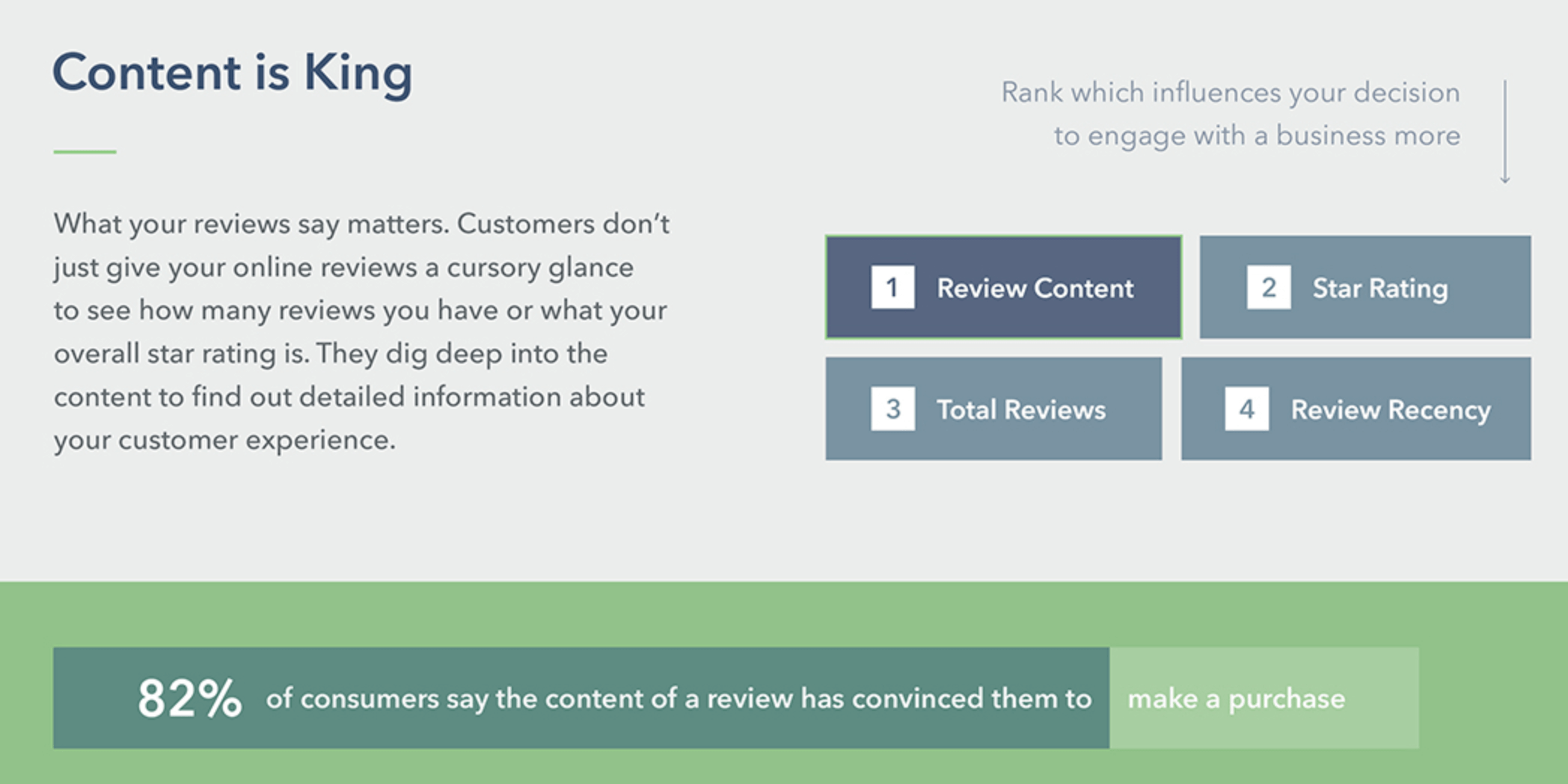
So it turns out it’s not just me and you – we’re all paying a lot of attention to customer reviews! Delving deeper, I found some other fascinating research about customer reviews:
- 86% of customers say they read up to 10 reviews.
- 91% of 18-34 years old trust online reviews as much as personal recommendations.
- 57% of consumers will only use a business if it has 4 or more stars.
- 89% of consumers read businesses’ response to reviews.
Reevoo also found that a mix of good and bad reviews actually makes your good reviews more trustworthy (which kinda makes sense – would you trust a product that only has 5 star reviews?). Bad reviews were found to improve conversion by 67%. So don’t panic the next time you get a bad review – it may actually be helping you! Reevoo also found that the biggest increases in conversion rates happen when a product goes from 0-30 reviews.
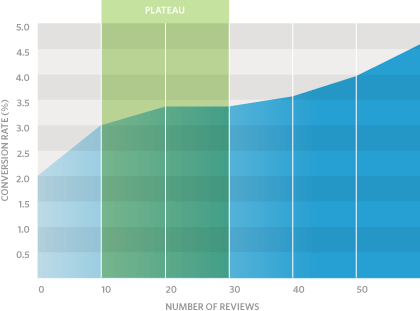
Yotpo also have some fascinating insights on consumer behaviour based on customer reviews. They found that conversions drop off significantly for products that have a 5/5 rating and that conversions a far higher for products in the 4.7-4.8 range.
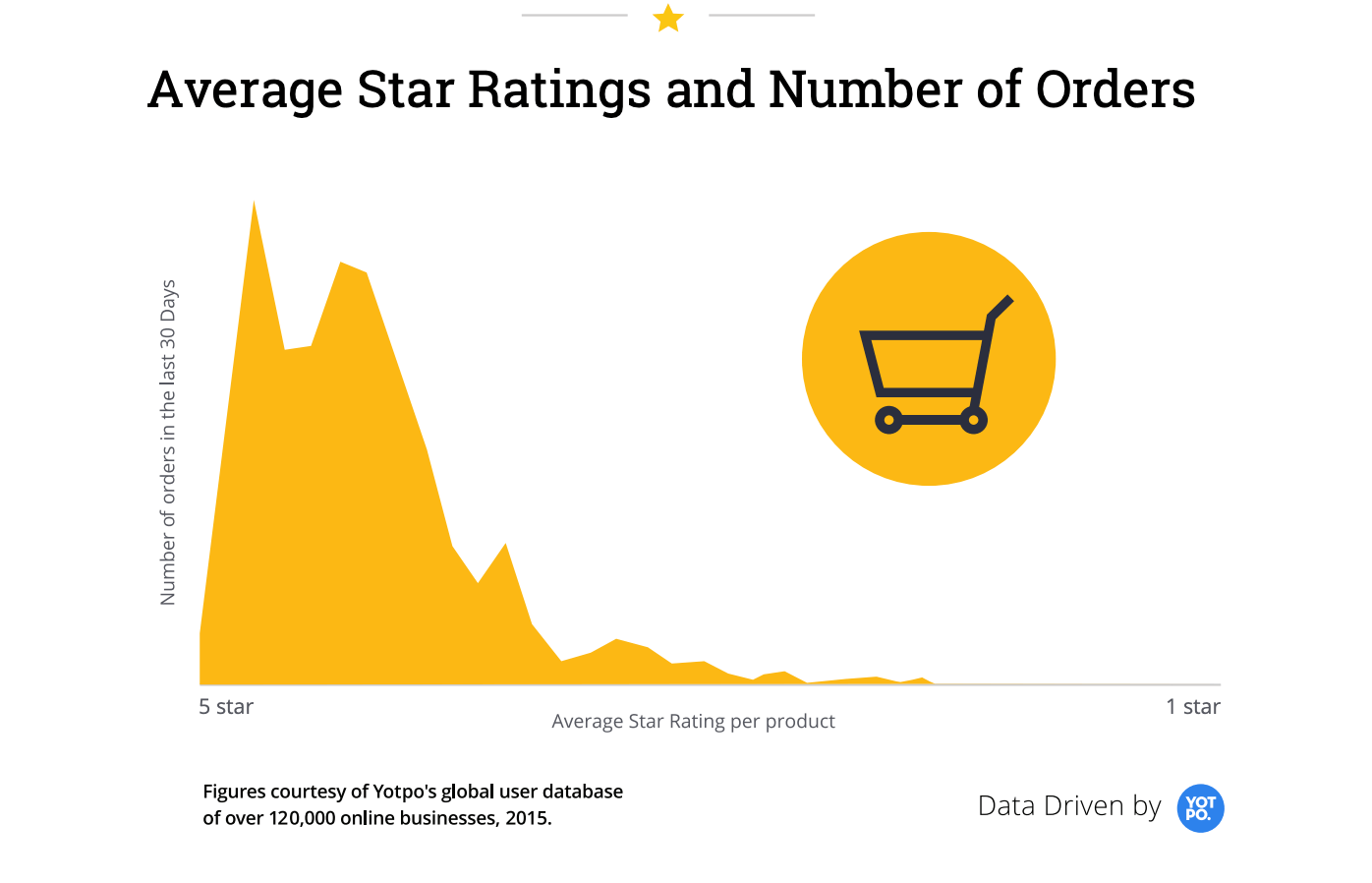
In the same report, Yotpo also found that for the 120,000 eCommerce websites in their study, the vast majority of customer reviews are very positive. Yay humanity! Generally speaking customers will leave reviews if they have a very positive or very negative experience. Which again makes sense – but it’s very encouraging to see a large study confirm this at scale.
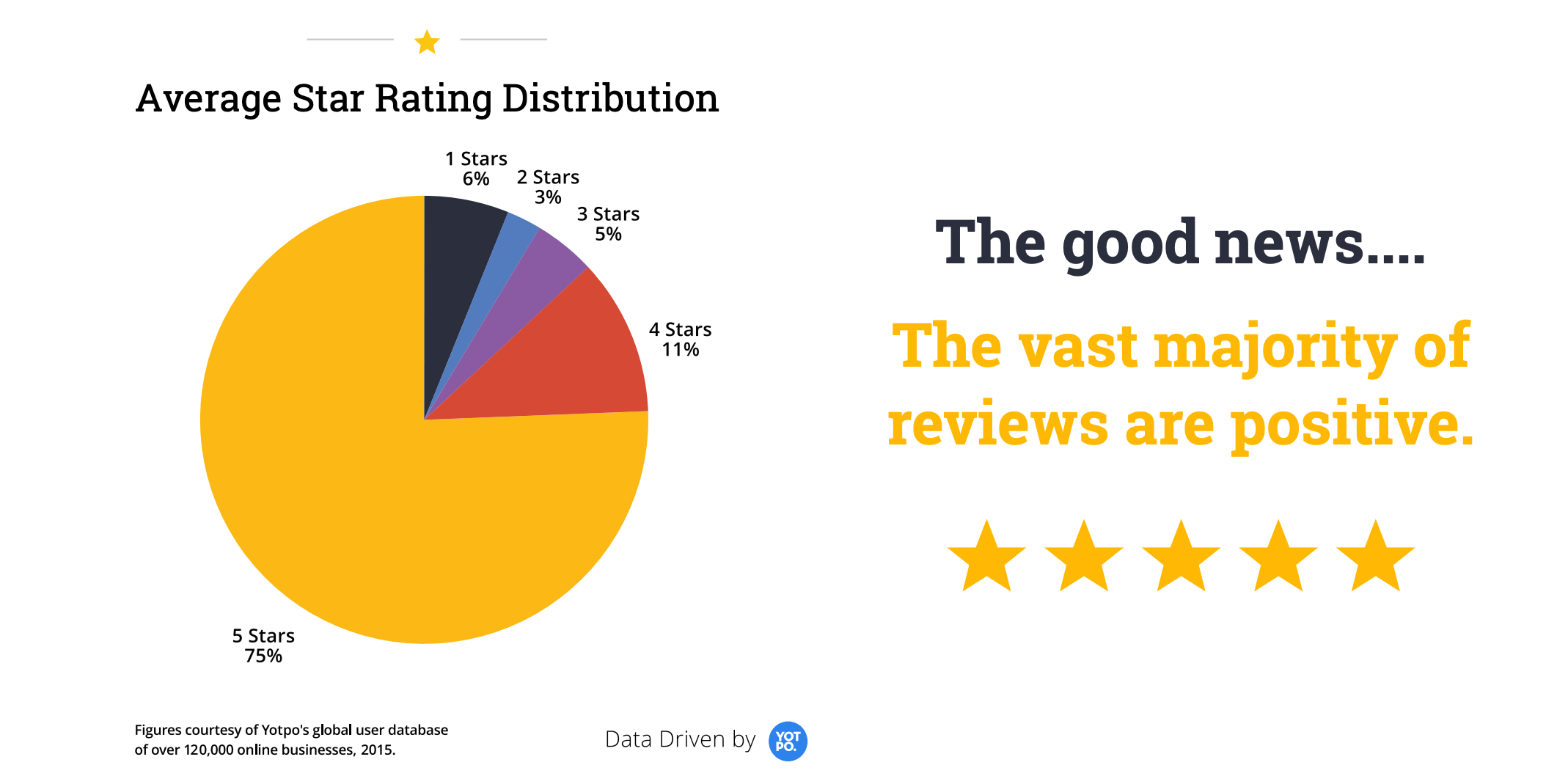
On the SEO side of the house, a balanced set of good quality reviews has several major benefacts to your search engine performance:
- Improved CTR from SERPS thanks to rich snippets showing product ratings. (ConversionXL found a 35% CTR increase.)
- Improved ranking for specific keywords by providing search engines with higher quality signals about your products and services. Simply put, Google trusts what your customers say about your products more than what you say.
- Offsite/external reviews in places like Google/Facebook/Yelp help drive inbound traffic to your website and are an invaluable source of authority and signalling to search engines.
So now we know just how important customer reviews are for your eCommerce website, let’s take a look at how to enable WooCommerce reviews.
How do I enable reviews in WooCommerce?
The core WooCommerce plugin ships with a reviews feature that is pretty straightforward to setup. First, go to WooCommerce -> Settings and scroll down to the Reviews section. I generally tick all the boxes here for best results.
- Enable product reviews: quickly toggle reviews on/off 🙂
- Show “verified owner” label on customer reviews: this is really important to switch on as it ensures reviews left by genuine customers are labelled correctly – increasing the trust factor of your customer reviews.
- Reviews can only be left by “verified owners”: Again this is an important feature to enable as it stops your WooCommerce store from being inundated with fake/spam reviews.
- Enable star rating on reviews: I can’t think of any store that wouldn’t want star ratings 🙂
- Star ratings should be required, not optional: Again, this is important to ensure you collect a rating and not just review content.
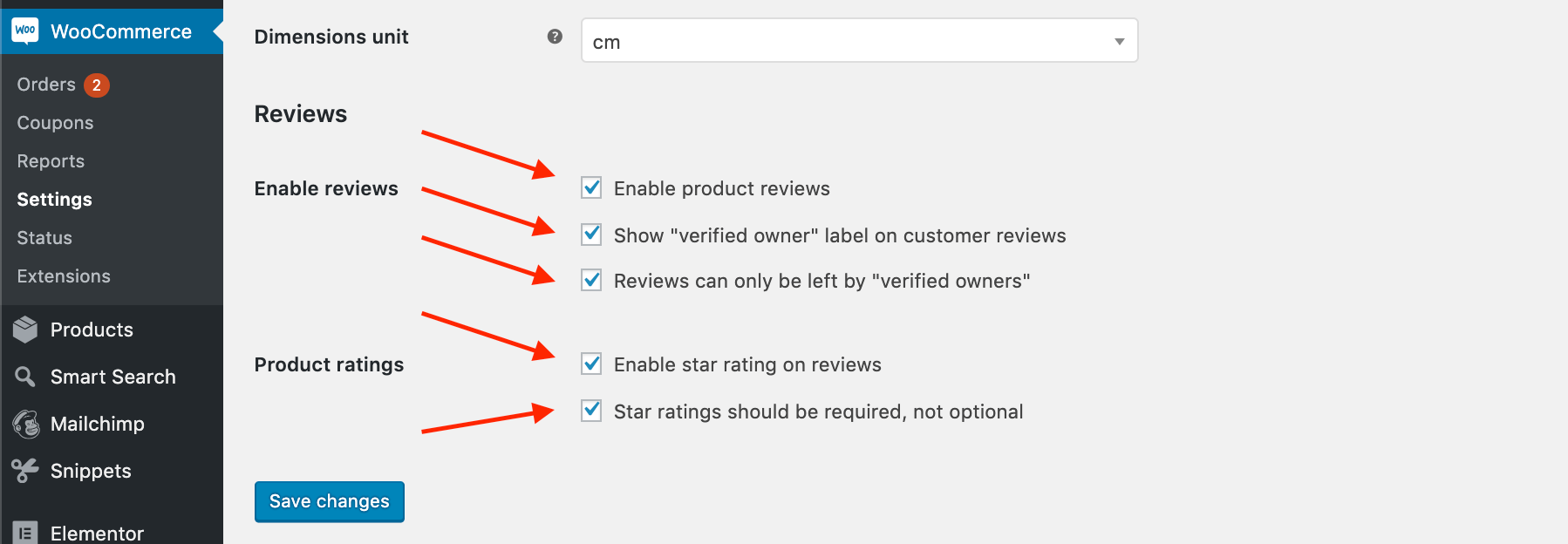
Once you’ve saved changes, head back to one of your product pages and you’ll see the WooCommerce Reviews tab now appears along with any published reviews for that product.
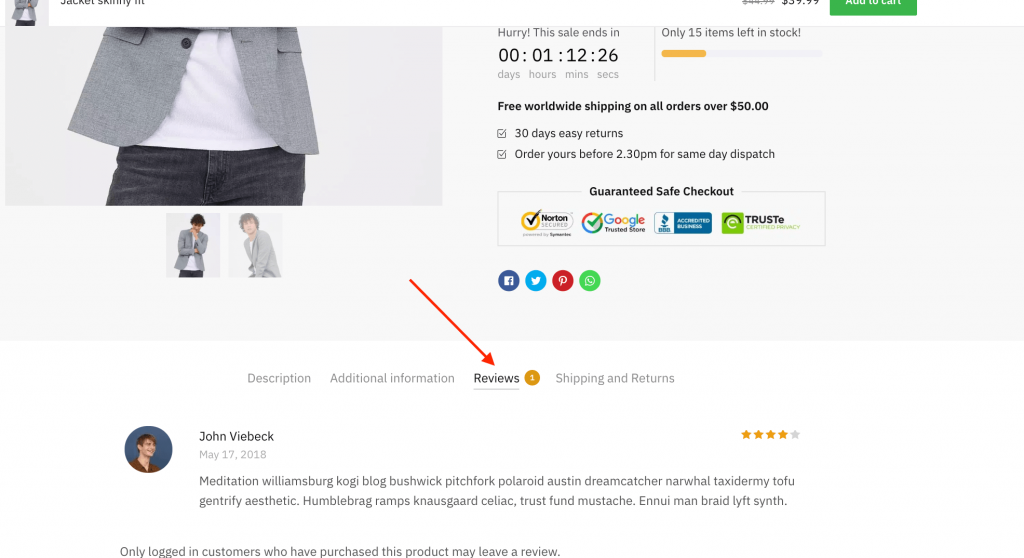
How do I add a review in WooCommerce?
To add a review in WooCommerce is pretty simple.
- Go to a product details page (PDP) for a product you’ve previously purchased.
- Scroll down to the reviews tab. (generally just under the product image gallery/add to cart button.
- Click the Review tab.
- If you’re using the settings above and are not logged in to the website in question you’ll probably see a message like “Only logged in customers who have purchased this product may leave a review”. If so, you will need to login to the store with the same email address used to purchase the product.
- Once you’re logged in, you should see the “Add a review” feature.
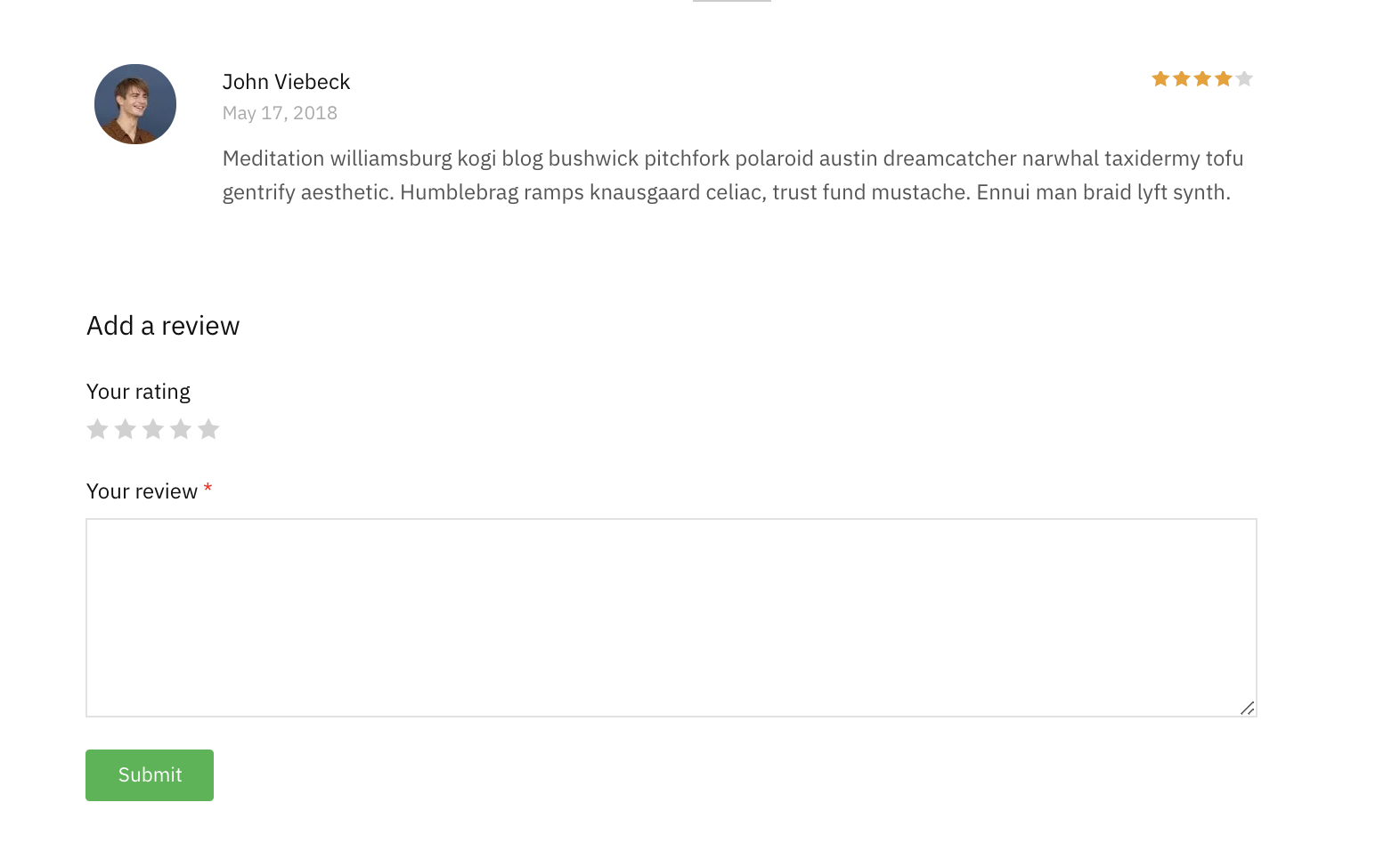
From here it’s pretty straightforward – go ahead and select a star rating and leave a review. In most cases, you’ll find that reviews are moderated and you’ll see something like this.

How do I manage WooCommerce Reviews?
Once a customer leaves a review, you should get an email notification telling you there’s a new “comment” for your product.

In core WooCommerce, reviews piggyback onto the core WordPress commenting system – hence why you’ll see reviews referred to as “comments”. It’s a bit of a quirk in case you were expecting a notification about a new review. If you open WP Admin -> Comments you’ll find your pending product reviews mixed in with any of your blog post comments (another WC pet hate of mine!). You can quickly approve a review from this screen.

If you’re really being brave you can head over to WP Admin -> Settings -> Discussion and switch off comment moderation to allow reviews to be auto approved without moderation but that’s definitely not a good idea 🙂 You might want to remove any offensive language before approving a review to go live for example. Once you’re happy with the review go ahead and approve it. You’ll then see it appear on your PDP.
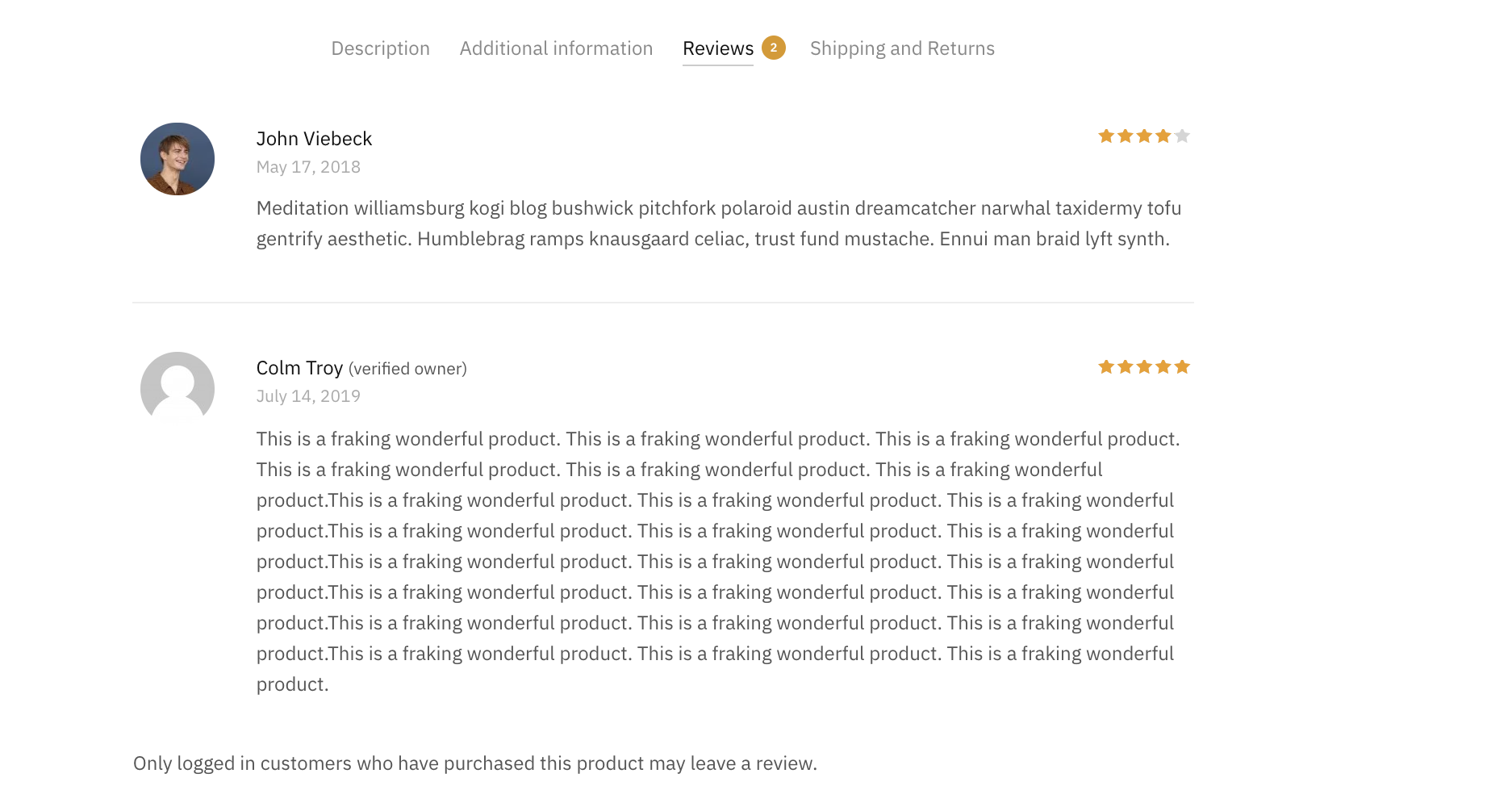
You’ll may have noticed that the oldest reviews are showing first above. Generally speaking it’s better to have reviews sorted by most recent first. Again this sensible default isn’t present in core WooCommerce because the sorting is dictated by WordPress comment sorting defaults. In blog posts I do generally like to see oldest comments first – so that default is sensible for blog posts. If you don’t care about your blog post comment sorting defaults you can quickly change your reviews to sort by most recent first by going to WP Admin -> Settings -> Discussion and set comments to show newer comments first.
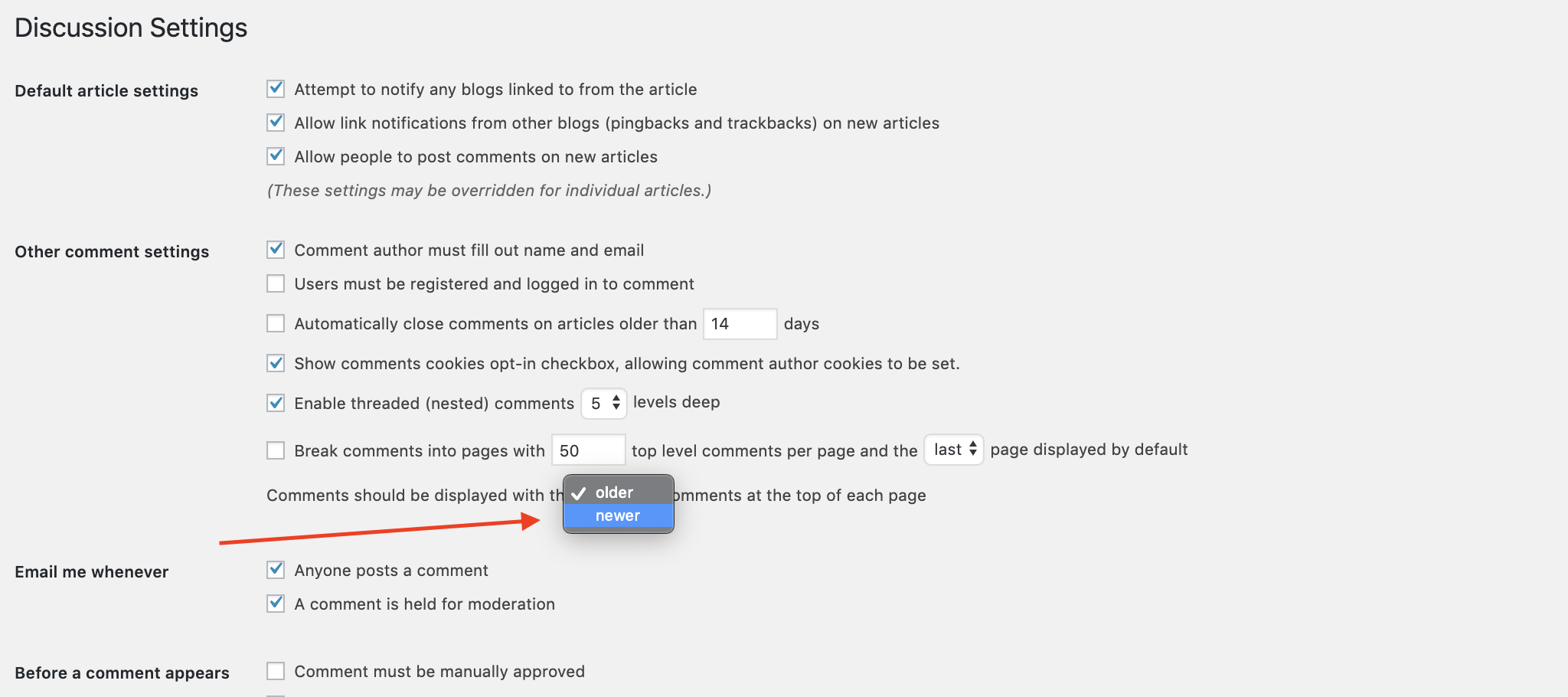
If however you’d like to keep your blog comments as is you’ll need this little code snippet to change the sorting for just your product reviews.
|
1 2 3 4 5 6 |
// show newest product reviews on top add_filter( 'woocommerce_product_review_list_args', 'newest_reviews_first' ); function newest_reviews_first($args) { $args['reverse_top_level'] = true; return $args; } |
And that’s about it for the core WooCommerce reviews feature. Overall it works reasonably well but I think it’s fairly basic for what a modern eCommerce website needs to encourage customers to leave reviews and for store owners looking for more sophisticated review features and functionality that can be best summarized as follows.
Weaknesses of core WooCommerce reviews
- They’re glorified WordPress comments – As you’ve just seen above, cor WooCommerce reviews are basically just WordPress comments. While this means it’s very easy to setup the core reviews feature, I really dislike that reviews are just mixed in with all other blog comments and that I can’t easily change review sorting without relying on using WooCommerce filters via code.
- No support for images/videos in product reviews – For me this is a must have for any modern eCommerce store. Rich User Generated Content (UGC) including photos and videos from customers who’ve actually purchased and used the product in question are critical and powerful forms of social proof.
- No review workflow automation – This is a biggie. We all live incredibly busy lives. Customers need to be prompted and cajoled into leaving reviews. Review workflow automation allows you to setup an automated email campaign to ask your customers to leave reviews at appropriate pre-defined times after they’ve received their product. For example, if it’s a product you know your customer will receive and use within a couple of weeks after shipping, your review workflow should be to send your first review request after 14 days. You should then be reminding customers perhaps 7 days later and maybe once more 14 days later. Like any “set and forget” email marketing automation software, review automation workflows are essential to improve review submission rates for busy eCommerce websites.
- Basic review display features – In order for your users to actually trust the reviews they see on your product pages it’s really important to allow users to quickly search, browser and filter reviews in the manner they’ve come to expect from popular sources of reviews such as Amazon, Yelp, Tripadvisor and so on. Core WooCommerce reviews don’t really offer much in this regard apart from the verified customer label.
- No integration with popular email marketing and loyalty platforms – One excellent way to encourage customers to leave reviews is to offer them points in a loyalty club. Core WooCommerce reviews don’t currently integrate with any of the popular loyalty platforms that work with WooCommerce. Similarly, the ability to segment users based on whether they’ve left a review or not and build campaigns for them via Mailchimp, Klaviyo or Jilt is a serious limitation when it comes to increasing review submissions.
Thankfully, there’s no shortage of alternative WooCommerce reviews plugins, extensions and Saas services that offer far more compelling features and functionality than the core features.
The Best WooCommerce Reviews Plugins and Extensions
One thing you’ll notice about most my recommendations below is that they are mostly third party Saas recommendations rather than self-hosted WooCommerce plugins/extensions. There are some very intentional and import reasons for that:
- Review automation deliverability – without question I do not like relying on the WP cron or the WC action scheduler for review automation. I’ve seen things go wrong too many times and many different WooCommerce stores when relying on internal crons for critical workflows to make the decision to never rely on them again! Closely related to this is the risk of review requests ending up in spam traps because your web server is not designed to be an email service provider.
- Integrations with other third party platforms like Klaviyo, Swell and so on. Many of the better Review platforms offer tight integration with other third party eCommerce software that you might already be using or plan on using. Want to send Review requests via Klaviyo? Want to automate loyalty points allocation once a review is submitted? When you’re running a small scale eCommerce store you might get away with doing these kind of things manually – for a while. But at scale you need tight end to end integration between your review events and every other aspect of your eCommerce store.
- Social media integration – the most advanced Customer review platforms allow you to curate reviews from places like Instagram which really take your user generated content and social proof to the next level.
- Increased trust – Users often trust external customer review systems better than internal customer reviews. If a user can clearly see that you’re displaying reviews from an externally managed system like Trustpilot or Feefo they tend to trust those platforms more as they know it’s more likely that these are genuine reviews.
There are a few decent self-hosted WooCommerce review plugins YITH Advanced Reviews and Customer Reviews for WooCommerce (which you can see in action on the Shoptimizer demo), but I would only consider those if you have a very good reason not to use one of the recommended Saas based services.
Judge.me – Top pick for Best WooCommerce Reviews platform
Without doubt, Judge.me is my favourite customer reviews platform for any eCommerce platform. Judge.me started off life as a Shopify app before being ported over to WooCommerce. It still remains an incredibly popular Shopify app for managing customer reviews with over 1107 reviews and an overall rating of 4.9/5.
Their WooCommerce plugin surprisingly currently only has 900+ active installations! Despite this the plugin already has 38 5 star reviews – and not a single negative review. Given WooCommerce support is relatively new and Judge.me website barely even mentions support for WooCommerce, I think this plugin is one of the best kept secrets in the world of WooCommerce customer reviews 🙂
The onboarding process for getting up and running on Judge.me couldn’t be simpler. After installing the plugin via WP Admin, head over to the plugin settings. Clicking the “Click Here” to manage Judge.me reviews and settings instantly opens and logs you into the Judge.me web app
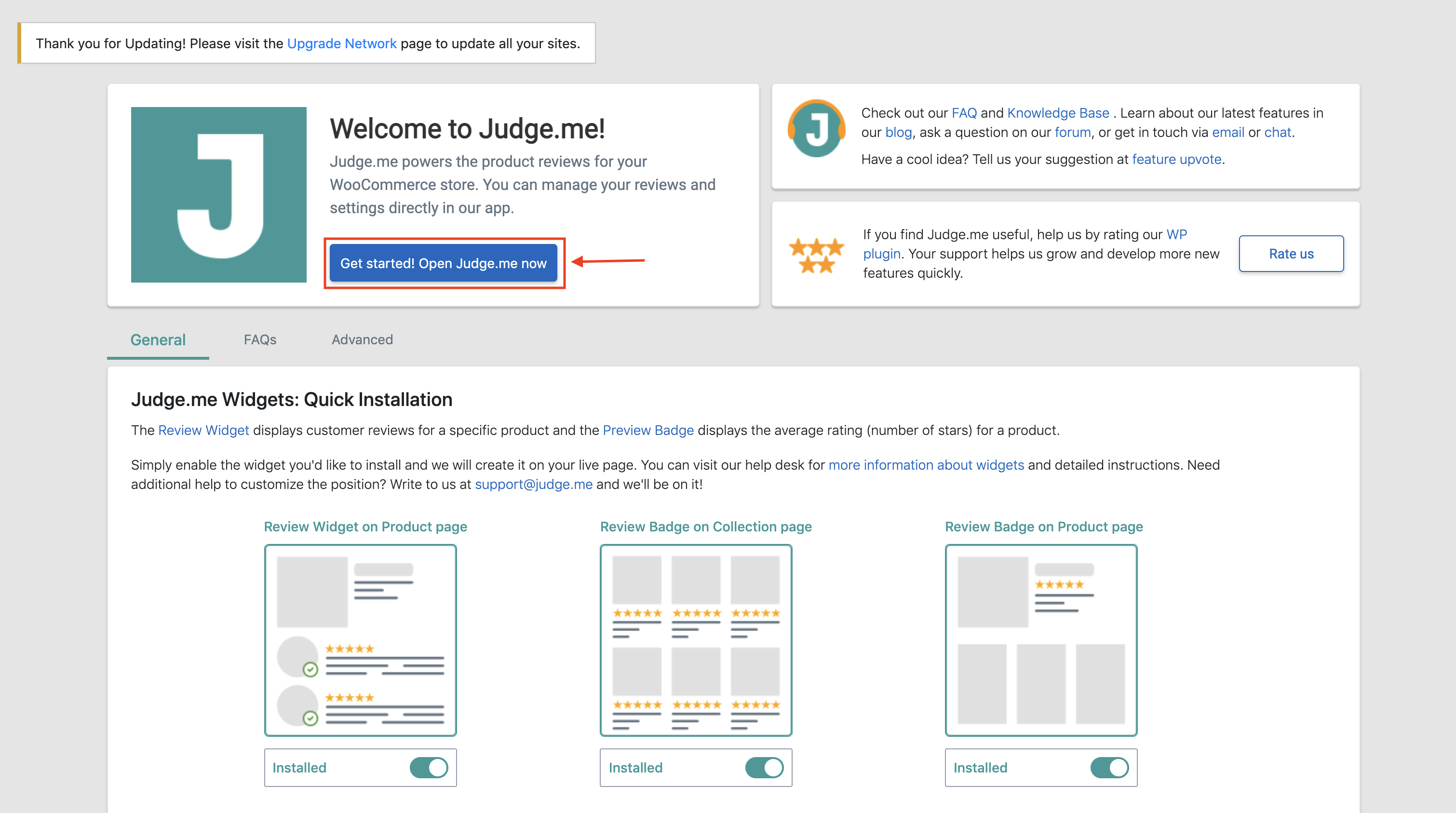
They use hash key to ensure the auto login is secure – which I thought made for a nice change instead of me having to go and register for yet another separate account. The Judge.me web app has been battle tested with thousands of Shopify stores over the years so while Judge.me is still relatively new to WooCommerce, their web app is very robust and full of all sorts of wonderful customer review features.
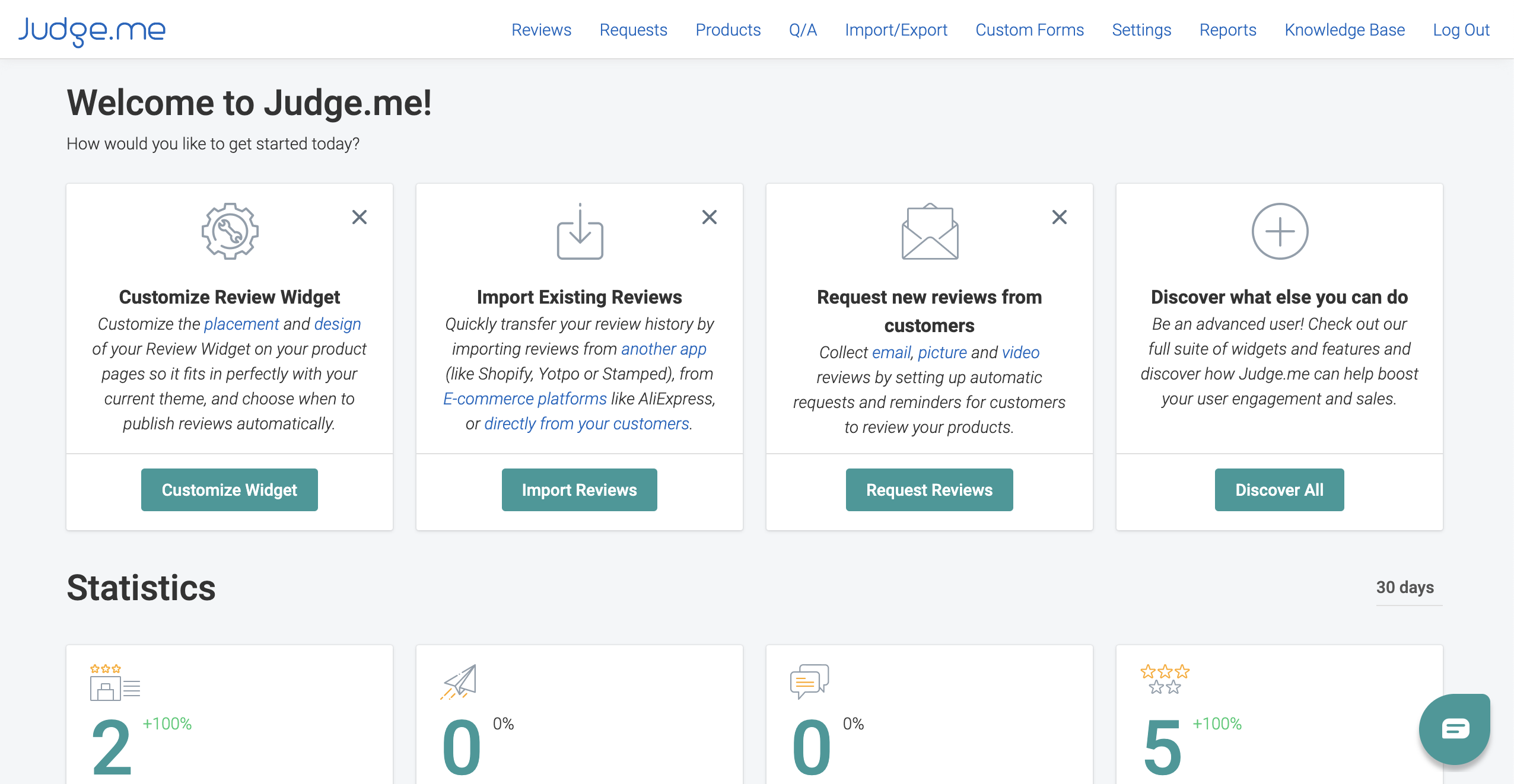
Back in the WooCommerce plugin settings you’ll see 2 buttons that we need to finish the Judge.me setup process.
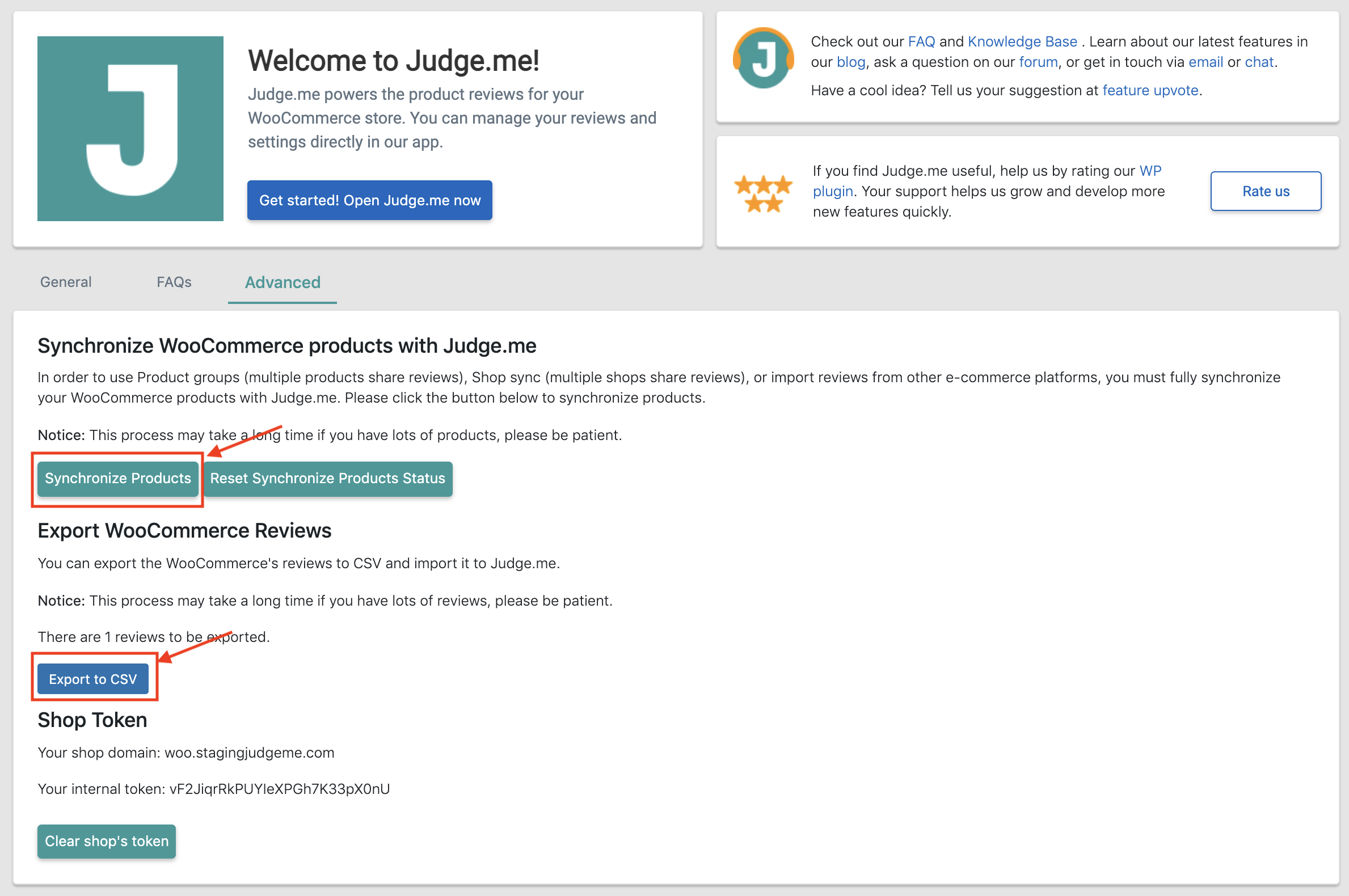
Clicking the “Synchronize Products” button will sync your product data with the Judge.me app. For me it took a couple of seconds for a catalog of approx. 50 products to sync. Obviously if your catalog is a lot larger and you’re running on a slower server this might take a bit longer.
Next, we click the “Export to CSV” button to download the reviews we have currently managed in core WooCommerce as a CSV file. Then, jump back over to the Judge.me web app and click “Import” button on the reviews screen.

Then click the “See all review apps” link to allow you to select WooCommerce as the source of your customer reviews.
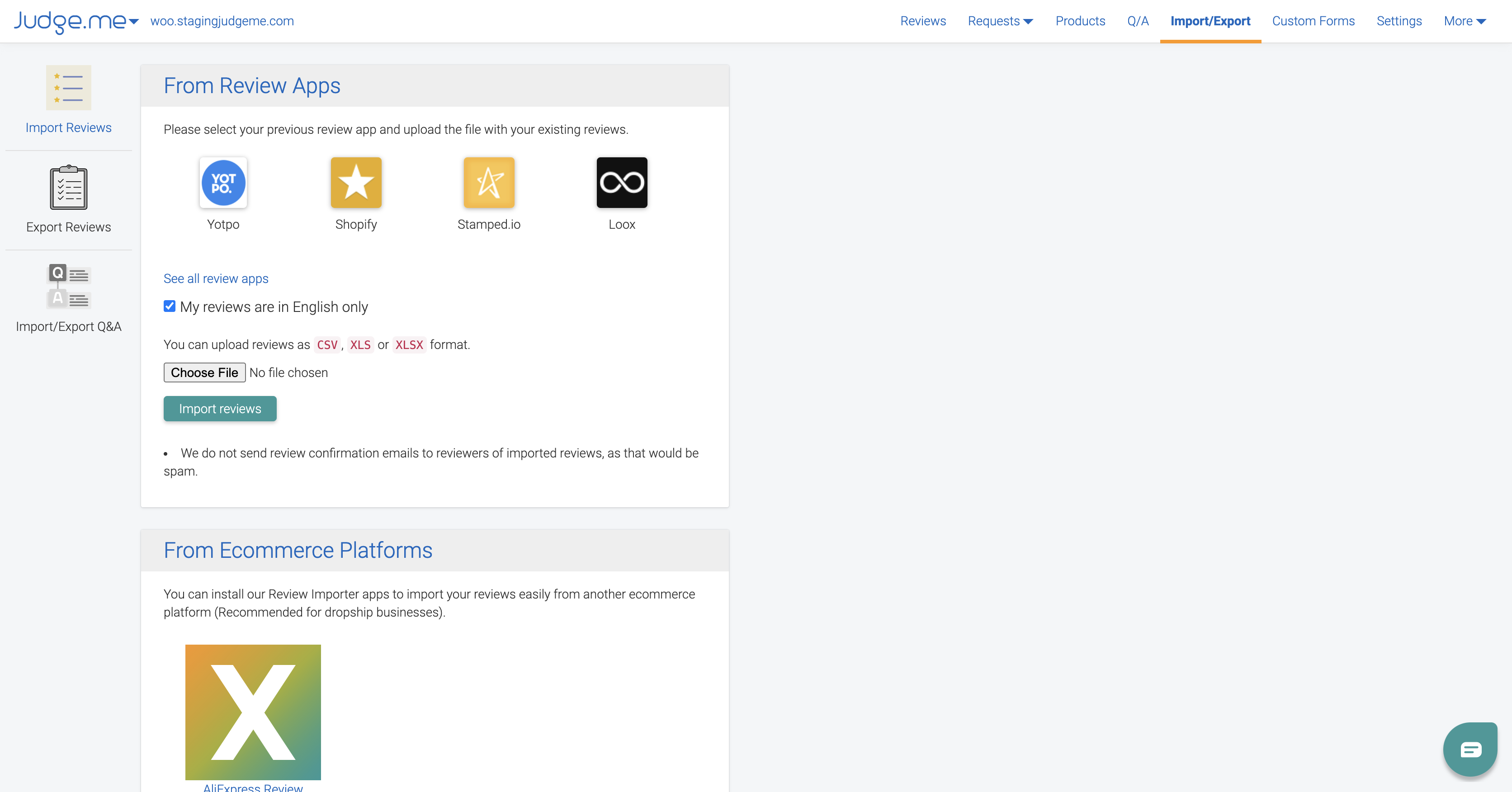
I was only importing 22 reviews for this store so the import process was almost instant. I’ve previously imported approx. 300 reviews in less than a minute.
Once the import is complete you’ll now find your reviews back on the main Reviews screen.
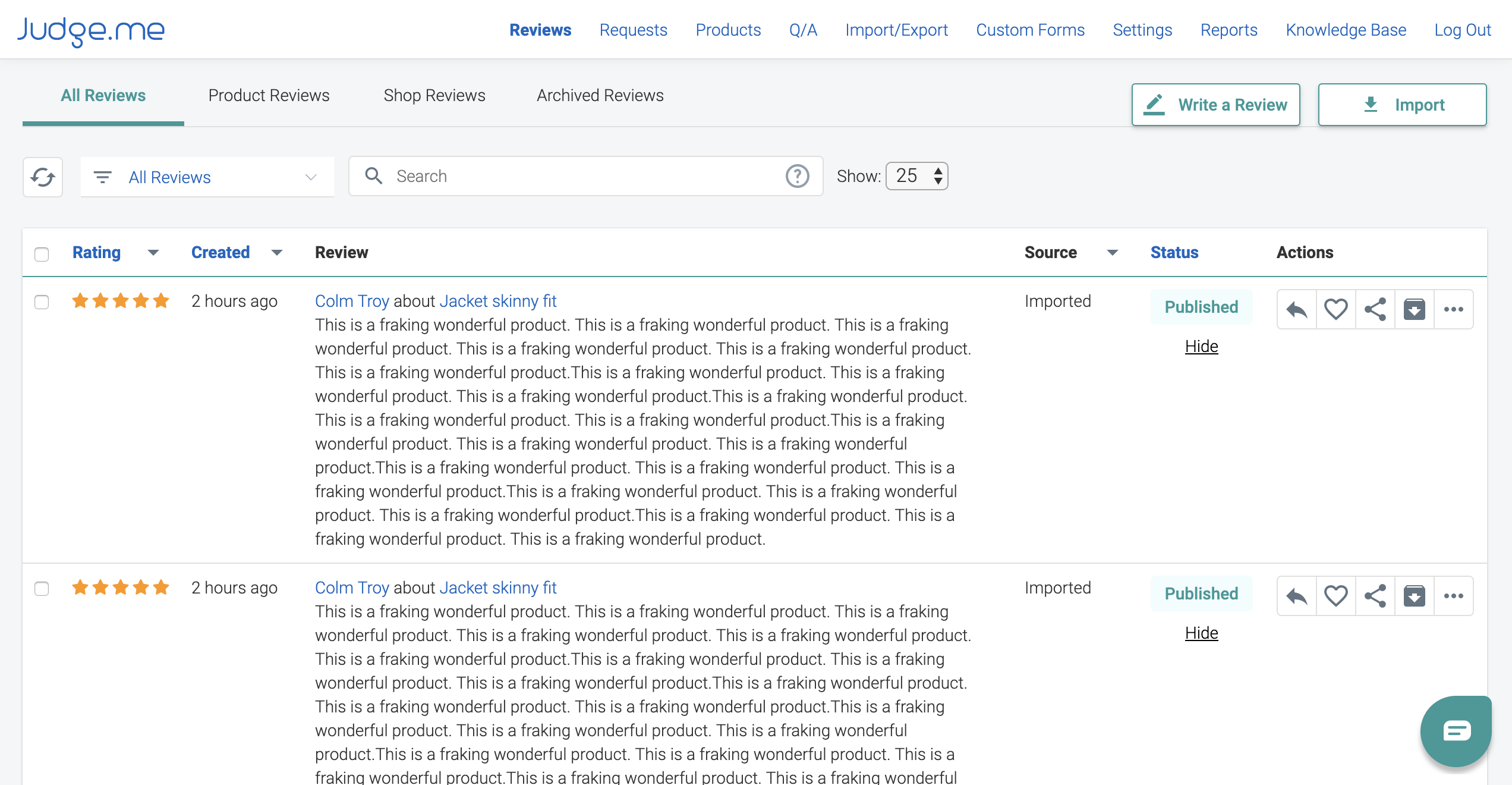
By default, the Judge.me WooCommerce plugin also enables itself on your PDP’s, so if you head back to one of your products and click the reviews link you should now see your reviews powered by Judge.me! You’ll also notice that your reviews are no longer hidden behind the old default reviews tab. Some people don’t like this. For me, it’s a major plus point. While search engines have gotten much better at spidering the contents of tabs, they still can be problematic. Hiding your reviews behind a tab may mean that Google doesn’t index your review content!
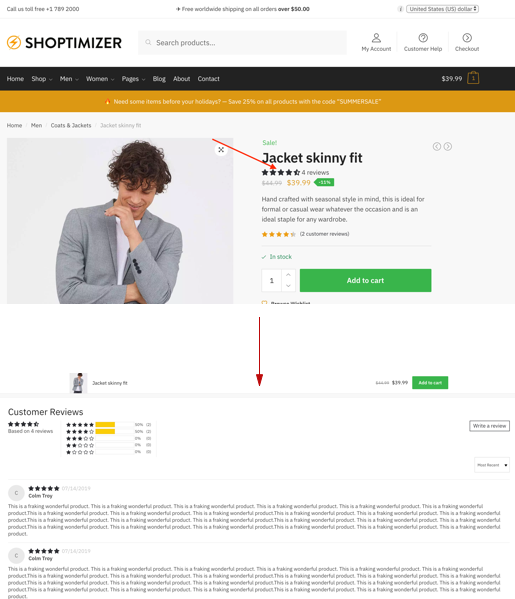
You’ll also see some simple options to toggle on/off review widget placement and star placement on both the PDP and archive/category pages. Judge.me refers to Archive/Category pages as Collections which is carry over from Shopify – they could probably do with changing that to cause less confusion 🙂

Back on the frontend you’ll find your reviews widget on PDP pages now have much better presentation and sorting options.

Once a user submits a review, 2 emails are sent – one to the customer who left the review to verify themselves and one to the store owner.
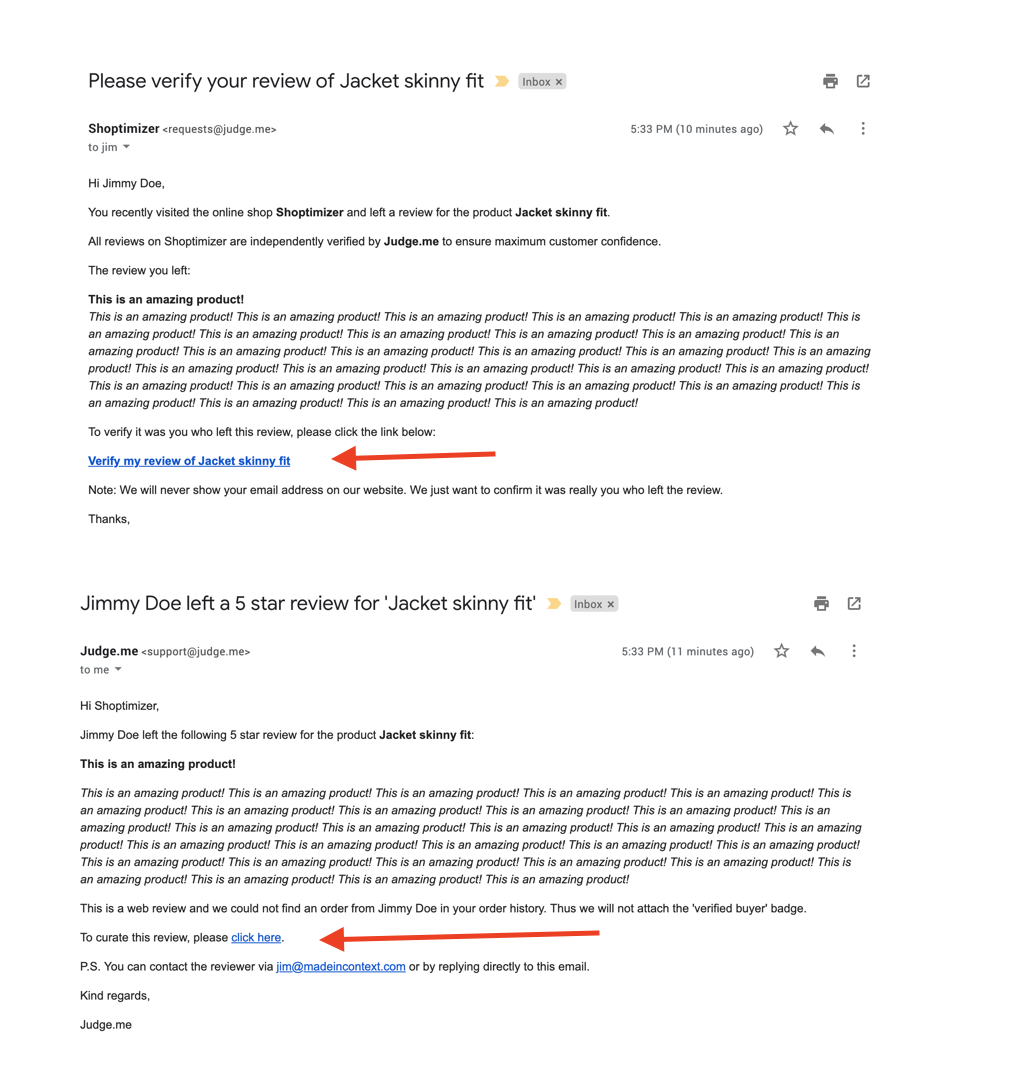
As the store owner you can quickly edit the review via the Judge.me web app.
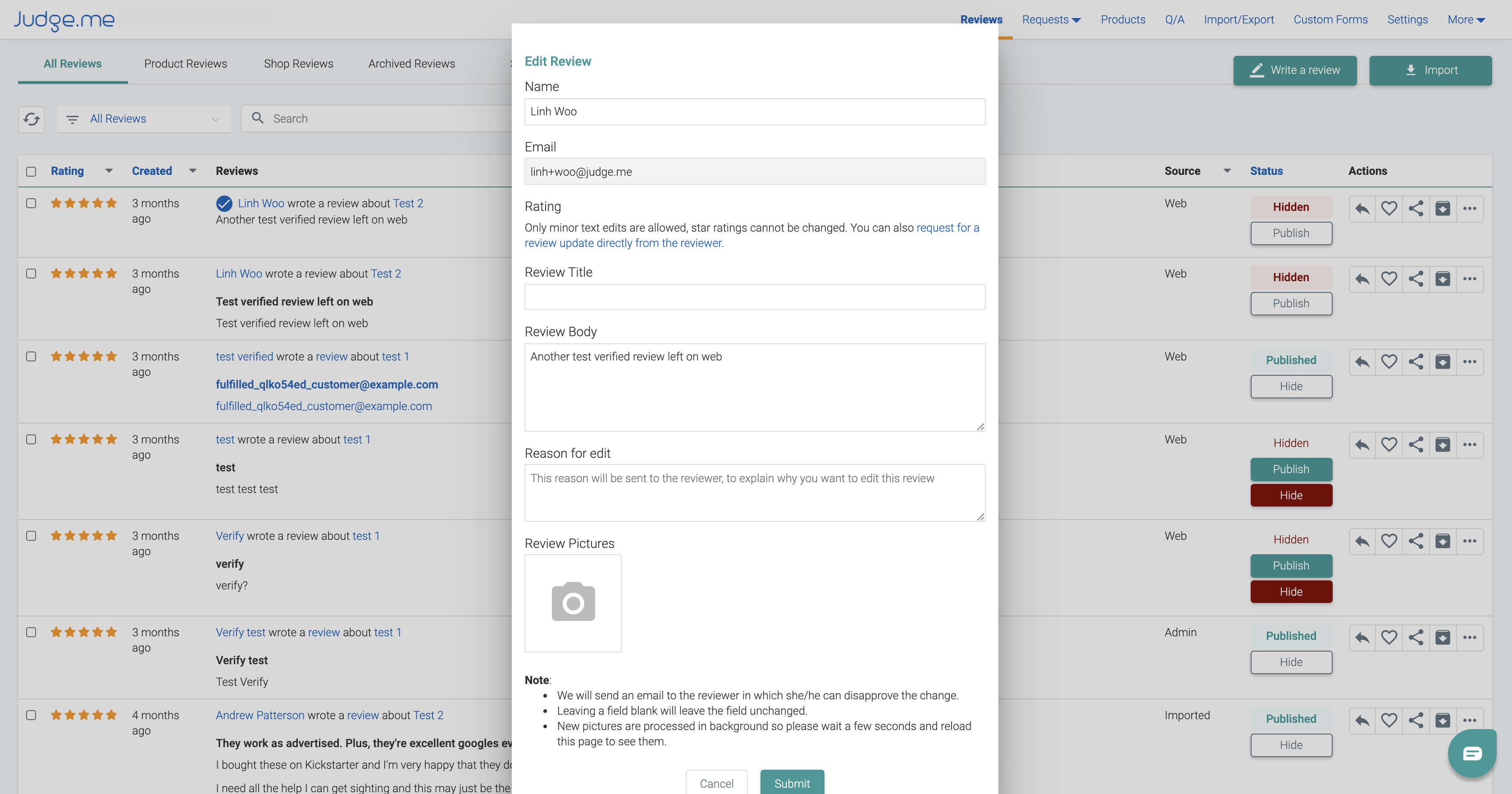
Judge.me Review requests
Here’s where Judge.me really starts to differentiate itself from your basic WooCommerce reviews plugins. After one of your customers has placed an order and that order has been marked as complete, Judge.me will automatically create 3 review requests for that customer.

- Review request 1 (for the first line item in the order) is scheduled to be sent 14 days after the order is marked as complete.
- Review request 2 (for the second line item in the order) is scheduled for 5 days later.
- Review request 3 (for the third line item in the order) is scheduled for a further 5 days after review request 2.
The timing of requests and sending follow up reminders is controlled within the Settings area.
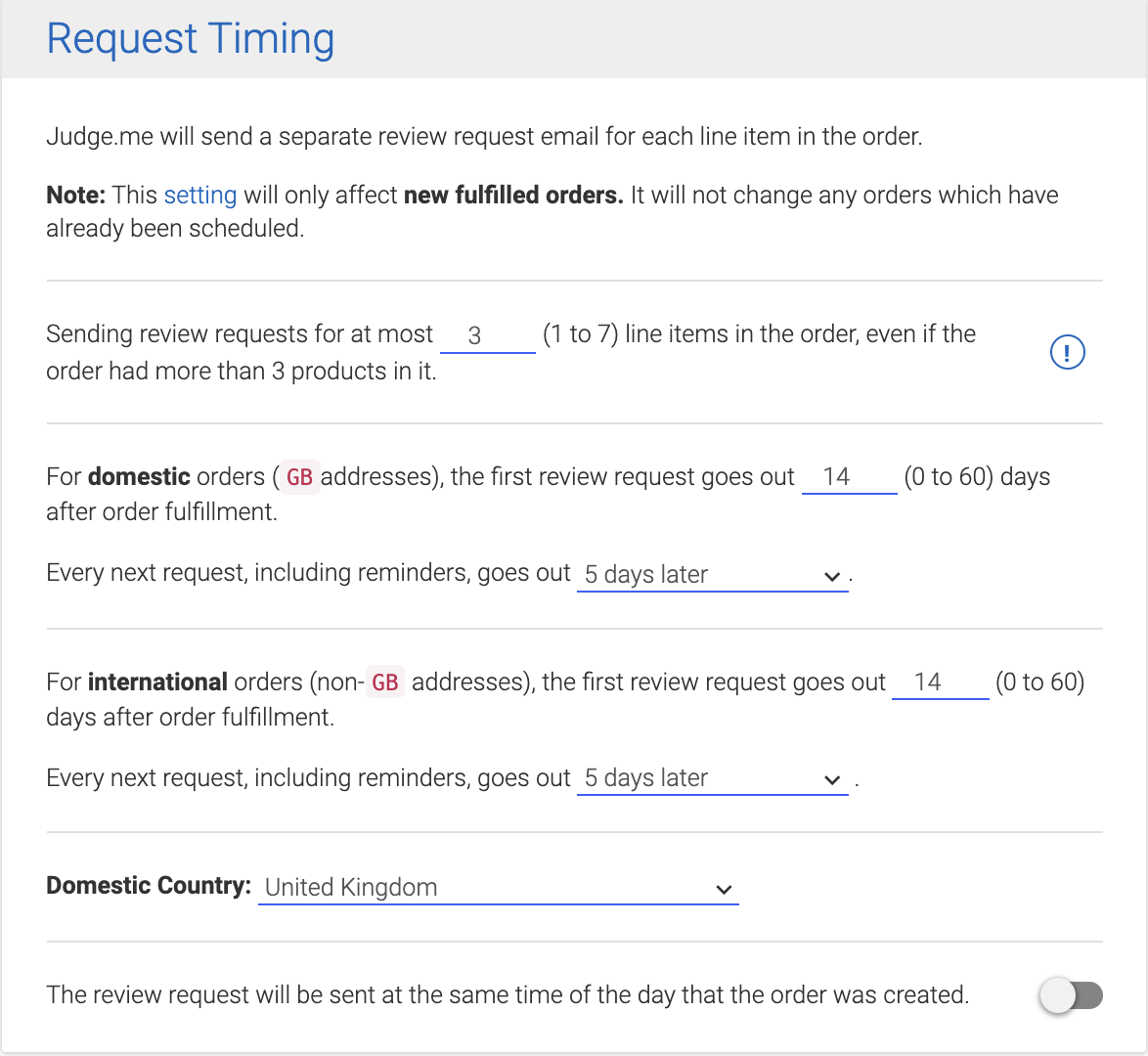
You can see in the screenshot above we’ve just enabled Automatic Reminders (this is set to 0 by default) which will send 3 request reminders.
If you don’t want to wait for Judge.me to do it’s thing automatically, you can force a review request to be sent on demand.

Which results in the customer getting the following email with a review request.
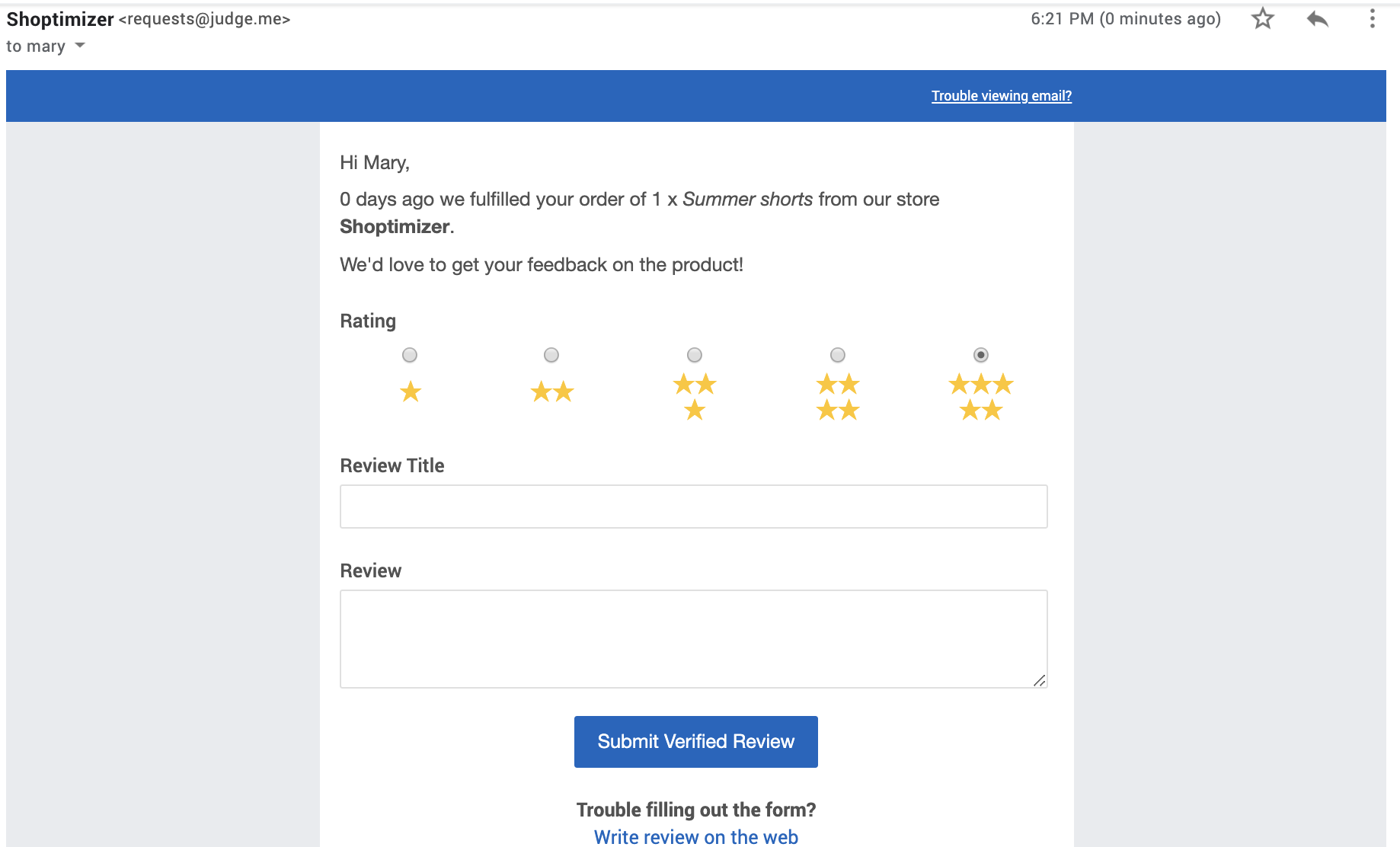
The customer can submit their review right from within the email which means collecting reviews couldn’t be any easier!
Judge.me – settings for everything you need – and some things you never knew you needed
In case you’re wondering if you can change that email template. Yip – you can. Judge.me provides a TON of settings you can explore.
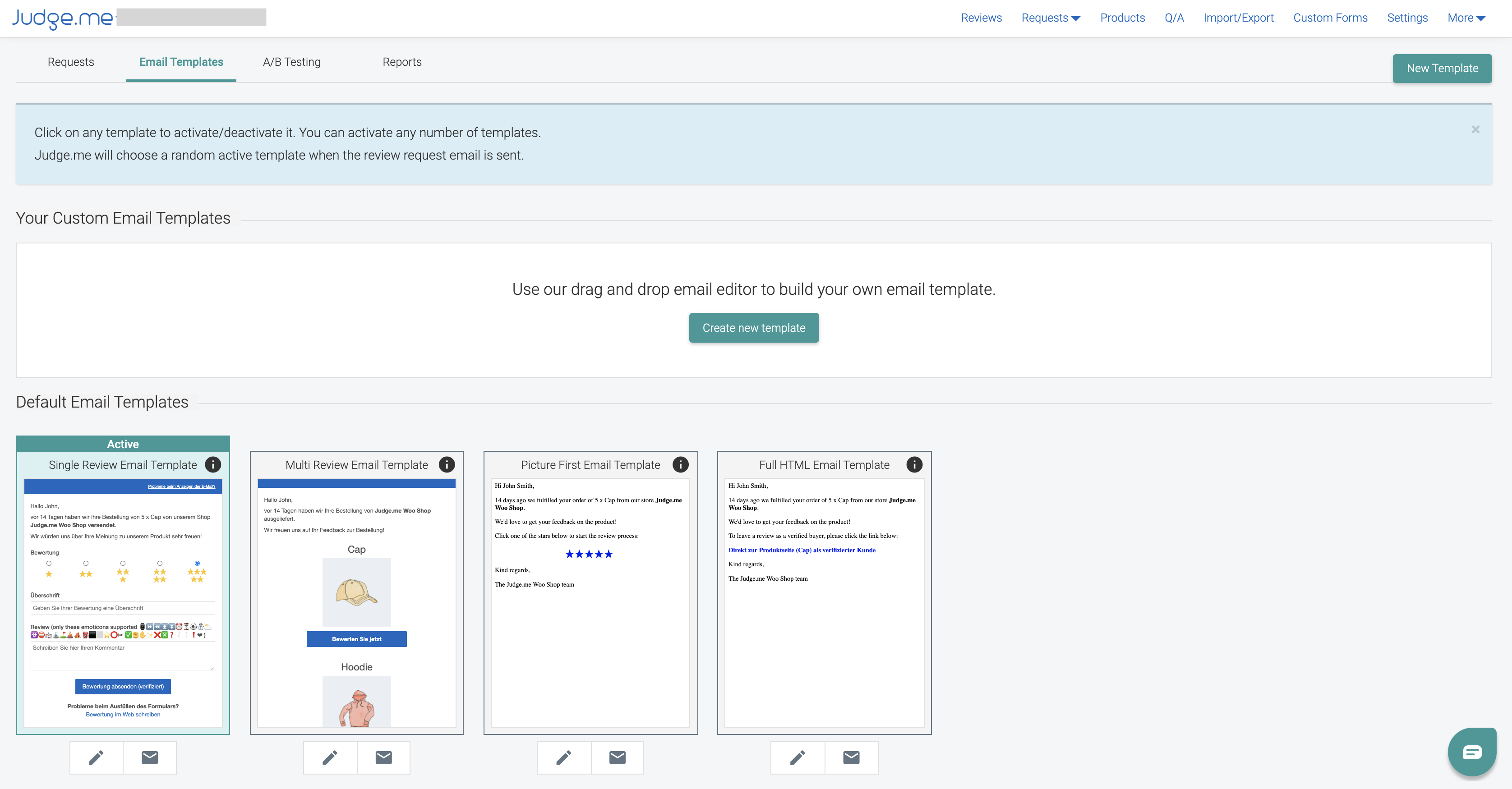
The email customizer is particularly well done.
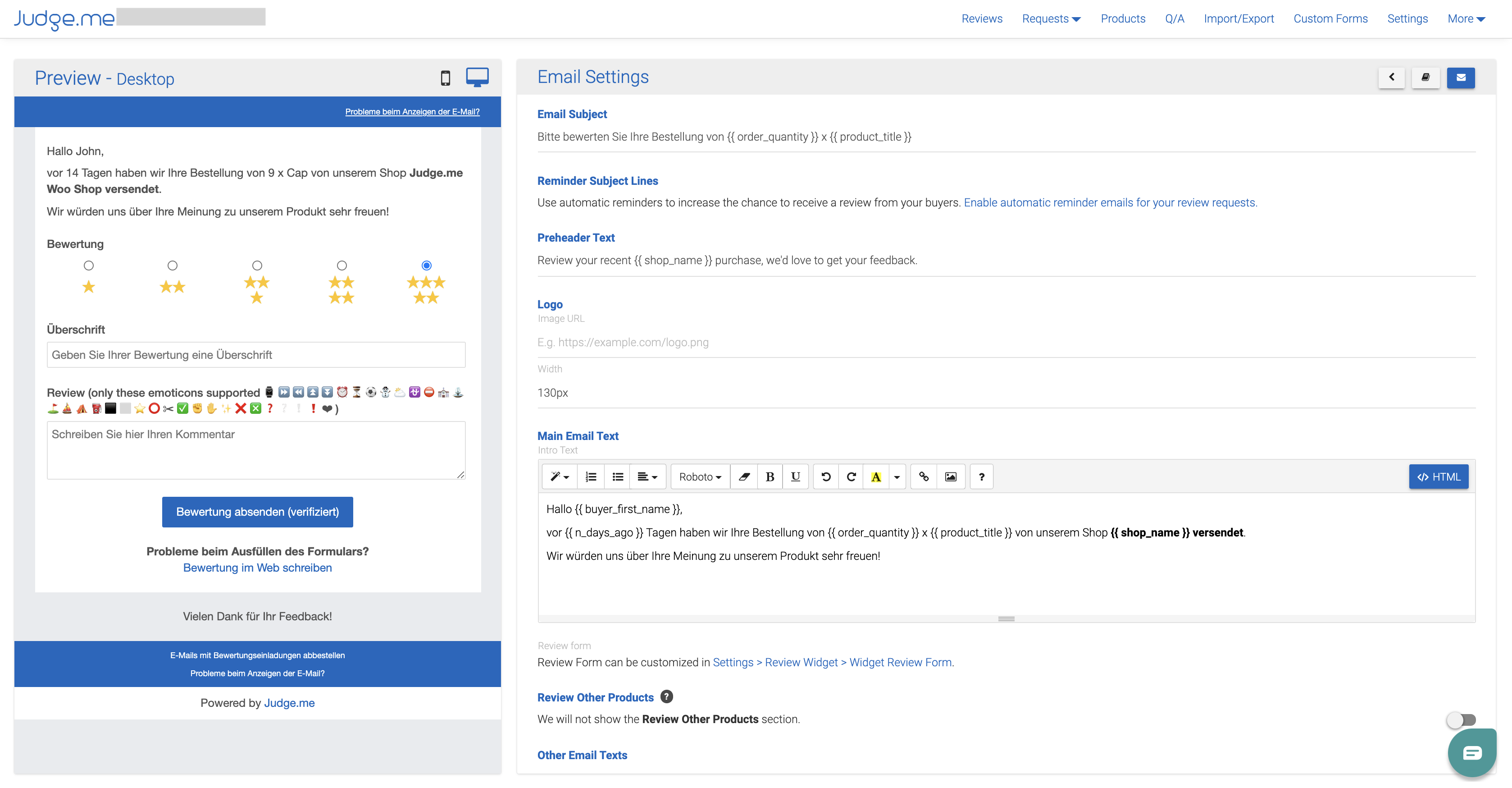
You also get a ton of control over the display of reviews.
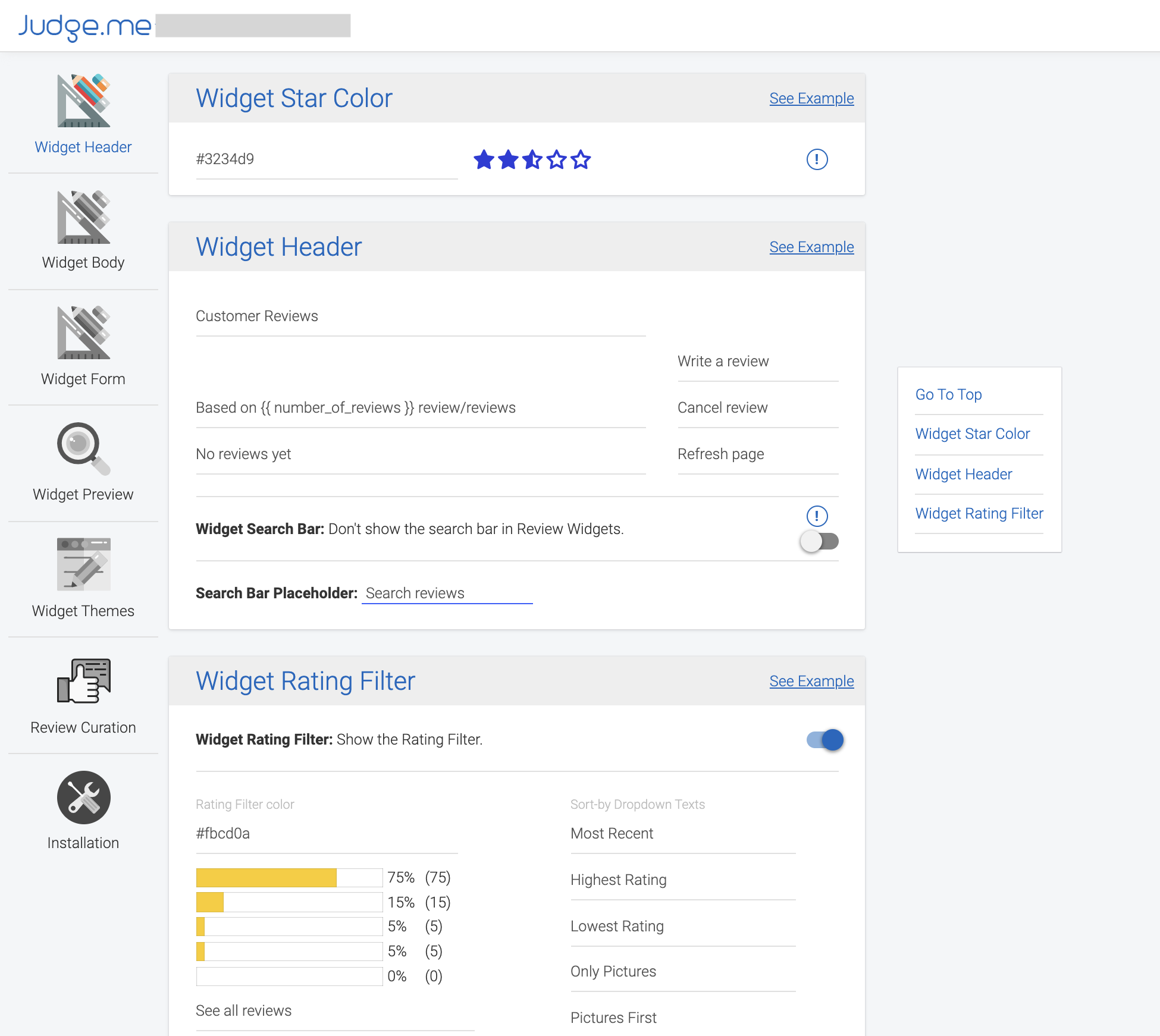
And all sorts of control over conditions about who should get review requests and more importantly – who shouldn’t.
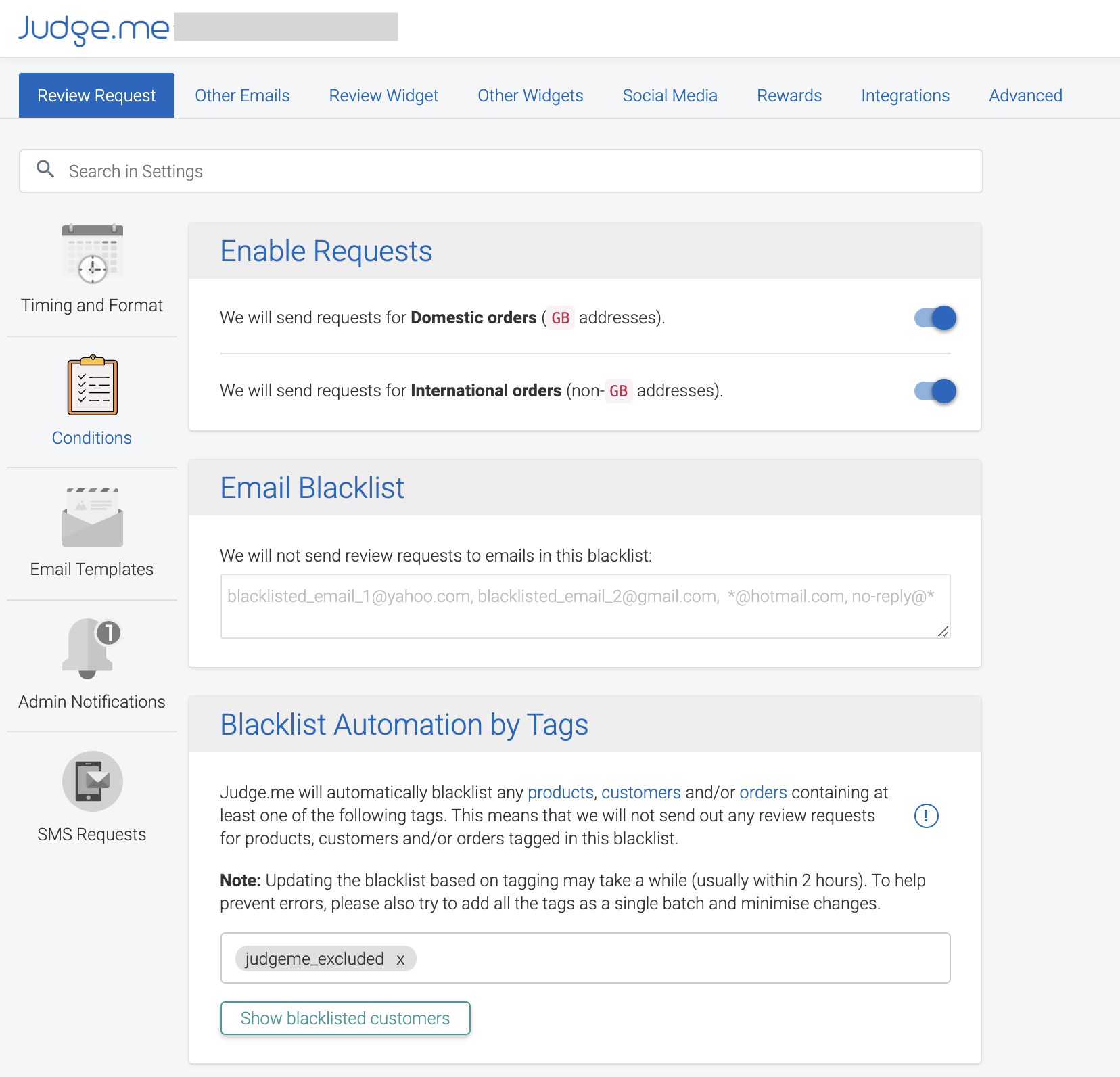
Judge.me for WooCommerce – any downsides? (and pricing info)
I could probably write another 2,000 words on how kickass wonderful Judge.me is – but I won’t – we’ve got some other platforms to look at 🙂 Suffice to say I was already a big fan of this web app when using it on Shopify stores and I’m delighted to say they’ve nailed their WooCommerce implementation. Lots of Shopify apps have started porting their platforms over to WooCommerce in recent times and have done a piss poor job of it. I’m really happy to say that’s not been the case with Judge.me and it’s really clear to me that the team there take a lot of time and care to implement features really well.
So is there anything it DOESN’T do well? Yes there are some blemishes here and there. The biggest is something many of the external review engines haven’t completely nailed properly yet – namely performance. As we’re now depending on a third party service to load our reviews, it means we’re adding additional js and CSS files to our frontend – which is something you know we don’t like. The good news is that for Judge.me we talking about 1 additional 83.9 KB js file and 1 additional 11.1 KB CSS file. Personally I’d like to see those scripts optimized further but the small performance impact is a worthy tradeoff for the immense value the platform is generating.
Judge.me Pricing
The other subjective con is price 🙂 If you’re suffering from Saas fatigue signing up for yet another subscription service might be the last thing you want to do. And I get – I truly do. But customer reviews are so important to the success of an eCommerce website that I feel very strongly that it’s one of the few areas that you should be willing to pay whatever it takes to get your review workflow done right. It can be the different from mediocrity and a roaring eCommerce success. The fricking amazing news is that you pretty much get almost all the value Judge.me provides for the princely sum of ZERO per month. Yes, everything you’ve seen so far is 100% free 🙂
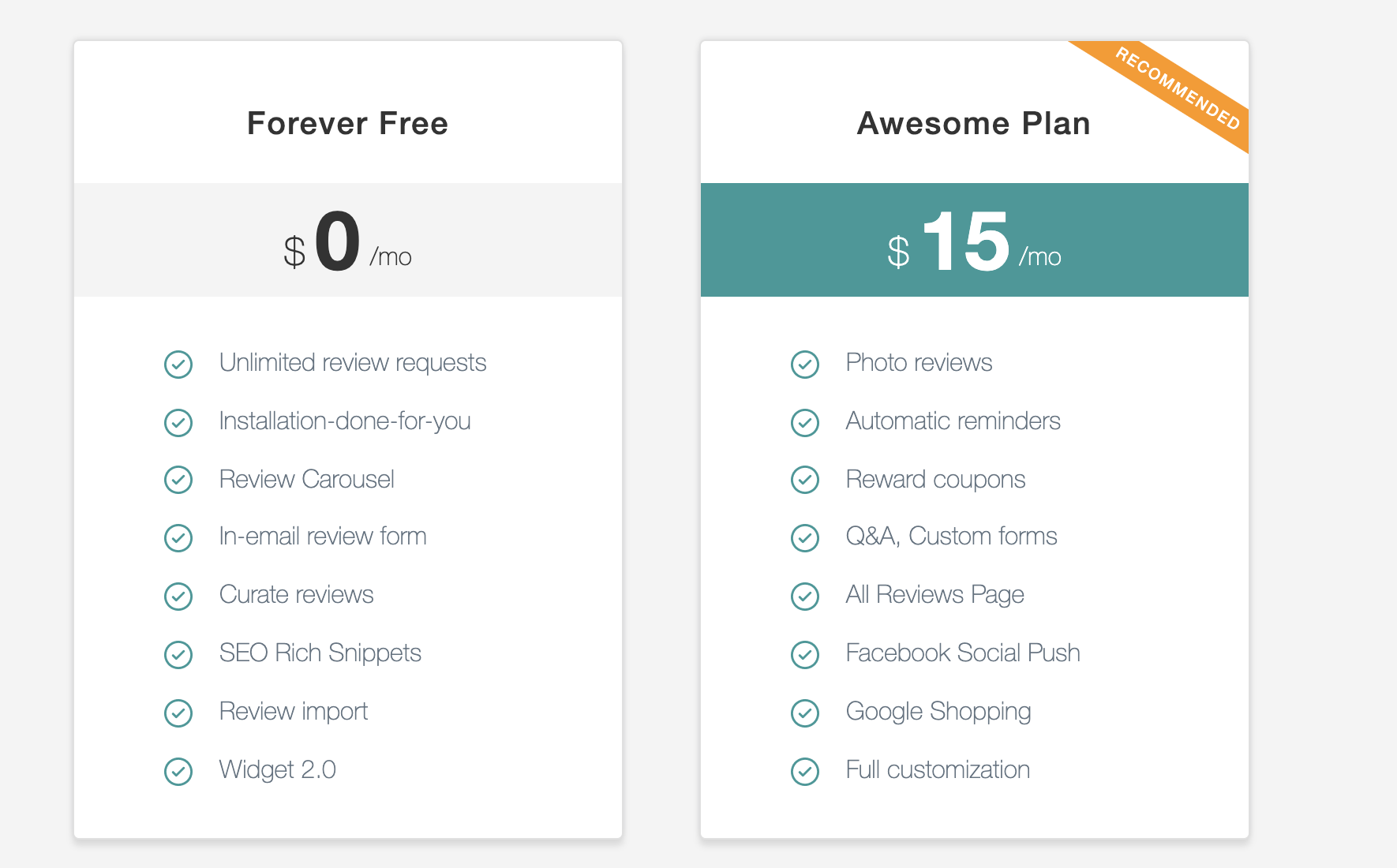
The unlimited review requests on the free plan is particularly compelling. The $15/mo plan gives you some key bells and whistles like Photo reviews and Facebook social push. Both of which are worth the upgrade alone – but the free plan will get you very far. I honestly don’t know how they’re able to give away so much value for free. I now put them up alongside Jilt as being my favourite eCommerce software service.
Stamped.io – Runner up Best WooCommerce Reviews platform
I’ve worked with Stamped on some very large WooCommerce websites with thousands of customer reviews. It’s quite similar to Judge.me in terms of the scope of features their service provides – so I won’t go into the product in the same level of detail as I just did for Judge.me – but rather I’ll highlight the key differences between the two.
- A much more limited free plan – Stamped has a free tier but it’s capped at 50 orders / month. In addition to the 50 order cap, the feature set in the free plan is severely limited vs. what you get on the free tier with Judge.me. Rich snippets for example aren’t included in the Free Tier. For me this is a dealbreaker to using the free plan as Rich snippets are now an essential part of your eCommerce SEO strategy. I would only recommend the free tier of Stamped if review scheduling is more important to you than on page SEO.
- A clunkier web app – While all the same features are pretty much in Stamped, I do see a lot more rough edges to their execution in Stamped vs. Judge.me. It’s not that anything is broken, it’s just the Judge.me user experience is more on point with how I think a reviews web application should work. But that’s my opinion – you might prefer how Stamped approach things so be sure to check it out!
- Heavier frontend – I’ve ran into issues several times in the past where Stamped was generating product images that were far too big for the review widgets they were being loaded into. Moreover when it comes to some of their more advanced widgets can take up to 3-5 seconds to load.
- More advanced email sequences – If you’re into tweaking your review automation workflow templates and sequences then Stamped edges out Judge.me for granular control over what content goes into each individual email sequence.
- Better enterprise features – Stamped have been innovating like crazy and adding many features like sentiment analysis, click tracking and a profanity filter. Perhaps one of their best differentiators in their Instagram Curation feature which is incredibly compelling and valuable.
Customer Support with Judge.me and Stamped.io
If you’re wondering how well both Judge.me and Stamped.io fare in terms of customer support, I can tell you that both companies provide excellent customer support. I’ve had many email conversations with Stamped in particular over the years and have always found their email response times to be lightning quick and satisfactory for the most part.
It’s hard to go wrong with either really so my advice would be to review both Judge.me and Stamped.io in detail and pick whichever platform suits your business better.
There’s one big feature that neither Stamped.io or Judge.me currently provide (although I know Judge.me are working on it) and that’s Google Seller ratings.
In short, Google Seller ratings are a Google Ads extension that shows your stores average star rating alongside your Google ad. Seller rating data is based on data collected from customer reviews. According to Google itself, adding Seller ratings to Google ads increases click-through rates by 17%. So if Google ads forms a big part of your Marketing budget and you want to include customer review data in your Google ads, you’ll unfortunately need to look further afield than Judge.me and Stamped.io for the moment.
The bad news is that the platforms that do support Google Seller ratings aren’t anywhere close to either Judge.me and Stamped.io when it comes to their WooCommerce integration. The other bad news is that they tend to be a LOT more expensive!
Nevertheless, let’s quickly cover what your main Google Seller ratings options are.
Yotpo Social Reviews for WooCommerce
Yotpo are one of the giants of Social commerce. With over a whopping $100M in venture capital raised, they’ve blazing a trail through the world of user generated content over the past few years and they were one of the pioneers of the Social reviews ecosystem. Their biggest strengths lie in the vast scope of their integrations with eCommerce platforms including Magento, Shopify, Shopify Plus, BigCommerce, Smile.io, Loyalty Lion, Mailchimp, Klaviyo, Zinrelo and many many more.
But what’s infuriating is that while they do support WooCommerce, it feels like it’s not a priority for Yotpo. You’ll find plenty of evidence for this in the plugin reviews and poor support for the plugin.
Yotpo is also expensive. The limited free version only includes up to 50 orders per month and is so limited I wouldn’t recommend it. Pricing info for paid plans isn’t publicly available but we know it quickly moves into the thousands of dollars per month range.
So why consider Yotpo at all? Well, if you’ve got good in-house technical resources and are prepared to build your own integrations, Yotpo have a best in class set of API’s that allow you to do VERY powerful integrations with not just WooCommerce, but basically any other eCommerce platform you use. They’ve also got that all important Google partnership for Seller ratings.
If Yotpo got their act together and made WooCommerce a priority platform for the business and introduced a mid tier pricing plan I think they could easily become one of the best Customer review platforms for WooCommerce – especially when you consider they also have an excellent Customer Loyalty platform product (formerly called Swell before it was acquired by Yotpo).
Trustpilot for WooCommerce
Trustpilot are another giant of the user generated content world. TrustPilot provides a free plugin to support WooCommerce. Their website claims they have over 7,000+ WooCommerce merchants which sounds impressive (although the .org repo page only shows 3,000+ active installations at the time of writing).
While the plugin is free and there is also a free pricing plan available, to get anywhere near to the feature set of Judge.me and Stamped.io you’ll need to pay a minimum of $299 per month. But again, you’ll need to decide what’s more important to you – Google seller rating support or a lower cost, more full featured solution with no Google seller rating support.
Other platforms with Google seller rating support include:
- Feefo – They’ve got a WooCommerce plugin but it hasn’t been updated in over a year and only has a few hundred installs, which is a shame as Feefo is quite a popular platform
- eKomi – They claim to have a WooCommerce integration but it doesn’t look to be available via the .org repo.
Wrapping things up
Customer reviews can make or break an eCommerce business. The core WooCommerce customer reviews leaves a lot to be desired but I hope we’ve shown you in this guide how you can work around one of the weaker aspects of WooCommerce to transform your user generated content strategy.
Have you tried any of the platforms we’ve recommended, or even better – do you believe you’ve got something better than what we’ve reviewed? Let me know in the comments below!
CommerceKit — Get automated reviews on your store!
Sign up to get a sneak peek as we build it, early access to our beta version and a substantial discount once we go live.







 Common WooCommerce mistakes
Common WooCommerce mistakes From Visits to Journeys: How to Drive Visitors Back to Your Store
From Visits to Journeys: How to Drive Visitors Back to Your Store SiteGround hosting for WooCommerce stores – worth your money?
SiteGround hosting for WooCommerce stores – worth your money? Link your WooCommerce store with Amazon using Veeqo
Link your WooCommerce store with Amazon using Veeqo
Better Reviews For WooCommerce is worth taking a look at.
https://wordpress.org/plugins/better-reviews-for-woocommerce/
Must take it for a spin soon Luke – thanks for the suggestion 🙂
Interesting choice to go for a 7 point star rating!
This is the best review of review providers I have seen. And it reinforces what I have suspected about your top two, Judgeme and Stamped. Your background info regarding the companies providing the service is particularly useful. Thank you Colm.
Martin
Glad to help Martin!
Hi there,
Very good review but there is 1 point to stress: when you use judgeme or stamped or this kind of supplier, your reviews are stored by a 3rd party, and then you are handcuffed. Meaning that, if, 1 day, the 3rd party decides to double their prices, what do you do?
So, recommend an alternative vs handcuffs would be wise.
Kind regards
Thanks for your comment – most of these platforms have an Import/Export feature so you can migrate to something else relatively easily.
This is the good review of review providers I have seen. I’ve had many email conversations with Stamped in particular over the years and have always found their email response times to be lightning quick and satisfactory for the most part. Very good review post.
Thanks for the article.
I find there are 2 issues about WooCommerce reviews: the first one is that it doesn’t email buyers automatically to ask for reviews (seems that the apps you mention solve that problem); but the 2nd one is that verified buyers need to log in in order to leave a review, and very often this confuses people. They don’t even realize that an account was created when they purchased.
Is this problem addressed and helped by any of the solutions you mention?
Thanks
Christine
Hi Christine, most of these review systems collect feedback primarily by email. And the emails are only sent to verified buyers so there’s no need to log in. The email itself has the star rating and feedback form embedded.
Thanks for the nice article, I think they are all SAAS platforms, Can you please give some idea about independent WooCommerce plugin? How about this? https://wordpress.org/plugins/reviewx/, It seems they have some user.